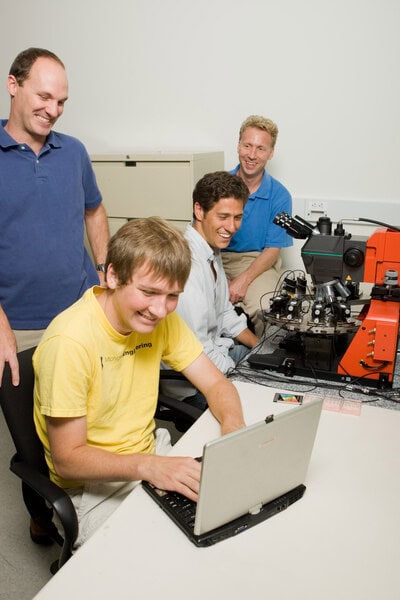University of Michigan startup Ambiq goes public

A technology that started in a University of Michigan lab is now helping batteries last longer in devices from Fitbit, Garmin, and Whoop, as well as smart glasses and medical wearables. Launched in 2010 as Ambiq Micro, Ambiq has made its initial public offering on the New York Stock Exchange under the ticker symbol AMBQ as it expands its mission to running AI models on similarly small devices.
“Ambiq is a powerful example of how federally funded research can become a technology that improves the everyday lives of many people, in this case by enabling more capable and convenient wearable devices,” said Dennis Sylvester, the Peter and Evelyn Fuss Chair of Electrical and Computer Engineering at U-M.

Ambiq was co-founded by Sylvester, the Kensall D. Wise Collegiate Professor of Electrical Engineering and Computer Science David Blaauw, and Ambiq chief technology officer Scott Hanson. Funded by the National Science Foundation, Hanson earned his electrical and computer engineering PhD in 2008 in the lab Blaauw and Sylvester share, developing the foundational Ambiq technology.
Now, Ambiq reports that it employs 190 people, and its chips have been installed in 270 million commercial devices. The company is pivoting toward bringing AI down from the cloud, solving the power bottleneck that makes AI models hard to run in wearables as well as smartphones, cameras, vehicles and more.
“Our chips are embedding intelligence everywhere. One of the coolest things is I can walk through any airport, any shopping mall, go to one of my kids’ sporting events, and I see the impact of our chips,” said Hanson.
Ambiq, an abbreviated portmanteau of “ambient intelligence,” is meant to evoke sensing and computing technology that is so unobtrusive and easy-to-maintain that it could exist anywhere people might want it.
The core problem that the U-M research team explored in the mid-2000s was how to push the boundaries of low power computing so that battery life stopped being a dealbreaker for wireless sensors. Hanson described transistors—the switches that control 1s and 0s in computers—like cups that get filled above a certain threshold. When a transistor runs at its design voltage, the cup fills all the way to the mark, and it’s clear that it is in the 1 state. When it’s empty, it’s clearly in the 0 state.
The question that Hanson was probing under the guidance of his PhD advisors was: how much voltage do you really need to transition to a different state? Instead of operating in volts, they operated in fractions of a volt. Hanson compared it to putting just a few drops in the cup and calling it the 1 state.
“When we first came out with this technology and showed it to other companies in this space, several technical people said this was exactly the wrong way to go about it,” said Blaauw. “Sometimes what turns out to be a good idea is not always well received. And it’s not always easy to distinguish, as some ideas are really not good ideas. Even if the idea is good, finding the market fit takes time and real perseverance.”

The research devices Hanson built were successful, up to five times more energy efficient than commercial devices at the time. But lower power comes with a lot of challenges. The smaller the voltage, the more sensitive the transistor operation is to influence from the environment, such as temperature. These were problems that Hanson and Ambiq’s early staff had to solve in order to launch a workable product.
Sylvester emphasized that success in the lab is very different from success in the market in terms of the number and quality of the devices produced.
“In research we make a few copies of a device, or a few dozen, and say, ‘Hey, this works!’” he said. “A company has to ship millions, and all of them have to work.”
By the end of his PhD, Hanson knew he wanted to start a company, and Blaauw and Sylvester were onboard. They connected with U-M Innovation Partnerships, which was known at the time as Tech Transfer. Entrepreneurship experts walked them through the startup process and licensing the technology that the team had developed and patented within the university.
Hanson spent an extra two years at U-M as a postdoctoral researcher, funded with a grant offered by Innovation Partnerships, doing additional trouble-shooting of the device. Sylvester recalled brainstorming at the Panera Bread on Washtenaw, figuring out the company name and what its first product should be.
“Scott leveraged every opportunity to present his work at conferences alongside industry veterans,” said David Hartmann, an advisor for Innovation Partnerships who worked with the early Ambiq team. “This honed his product technology model and provided the confidence to go to the big idea of an ultra-low-power microcontroller. While this was a very aggressive business model, Scott and his advisors were up to the challenge.”
By the time Ambiq Micro launched in January 2010, Hanson knew the microprocessor he wanted to build was too ambitious for a first product. Instead, Ambiq initially offered an ultra low power clock. One customer used it to create dynamic CVC codes—the three-digit security code on the back of a credit card. That clock fit inside the card, and its battery lasted until the card expired.
“It was a small chip that we were able to build with a small team, and that allowed us to solve some of these mass manufacturability questions that were not necessarily solved in academia,” said Hanson.
When that technology was successful, Hanson turned his attention to the challenge of building a low-power microprocessor, which became the Apollo series at Ambiq. At first, Blaauw and Sylvester remained on the Ambiq board, but as Hanson got deeper into the challenges of mass manufacturing, there was less need for scientific advisors.
Blaauw and Sylvester went in a different direction, with the startup CubeWorks focused on building entire computers that are a millimeter to a side. Attached with stickers, their primary product verifies that refrigerated items, such as foods and medicines, stay within their target temperature range from production to delivery to consumers.
In science, the computers have been used to track the migration of monarch butterflies and discover why one snail species survived a local extinction event. Soon, they will be integrated with brain implants in a research study to help stroke victims recover the ability to speak.
Sylvester is also the Edward S. Davidson Collegiate Professor of Electrical and Computer Engineering. Sylvester, Blaauw and the University of Michigan have financial interests in Ambiq and CubeWorks.
 MENU
MENU 
